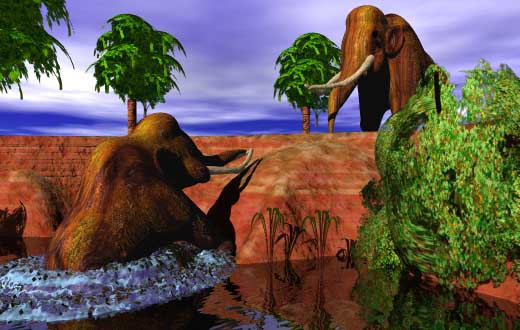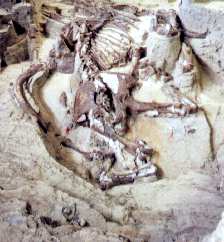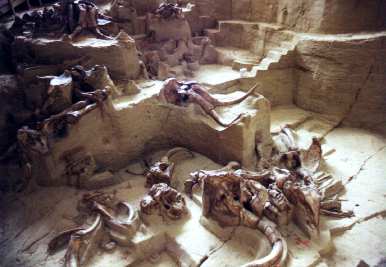pop up description layer
HOME
Cryptozoology UFO Mysteries Aviation Space & Time Dinosaurs Geology Archaeology Exploration 7 Wonders Surprising Science Troubled History Library Laboratory Attic Theater Store Index/Site Map Cyclorama
Search the Site: |
|
The Mammoth Trap
A
woolly mammoth desperately tries to escape the pit as a fellow
member of his herd looks on helplessly. The young bull mammoth looked down into the tantalizing water. He'd traveled dozens of miles across the dry plains of this region seeking a place to quench his thirst. This pool at the bottom of a steep-sided pit looked perfect. The water was still, and around the edges grew bushes and trees whose green leaves he could munch on after he drank his fill. While trying to carefully maneuver down the slope to a point where he could get his trunk into the water, the giant's feet slid out from under him on the slippery slope. He plunged into the water with a tremendous splash. He didn't panic, though. Mammoths were excellent swimmers and his feet could touch the bottom of the warm pool even in the deepest sections. He moved around the edges, drinking and eating from the bushes until he began to tire. Then he swam to the edge to climb out. He had gotten his front feet out of the water and onto the slippery red walls of the pit when suddenly the ground there collapsed and he found himself back in the water. Again he tried to climb out with the same effect. Now tired and desperate, the animal raced toward the wall again. This time he got his immense body completely out of the water, but before he could get a front foot onto level ground, the soil beneath his right rear foot collapsed. Now the mammoth found himself tumbling backwards into the water head over tail. The creature's huge, heavy tusks twisted his head around, breaking his neck. Slowly the dead giant slid to the bottom of the pit where loose sand covered his body, another victim of the Mammoth Trap.
It was in June of 1974 that bulldozer operator George Hanson got the assignment of leveling a small hill for landowner Phil Anderson. Anderson planned to build a housing development on land near the town of Hot Springs, South Dakota. As Hanson pushed the machine's blade into the hill, it hit something buried in the ground. Getting out to take a closer look, he saw what looked to be a seven-foot long tusk surrounded by animal bones. He showed the bones to his son, who in turn contacted Dr. Larry Agenbroad, a faculty member at Chadron State College in Nebraska. Agenbroad arrived at the site a week later and realized that he was seeing the bones of at least eight individual mammoths. But how had these mammoths, many in the prime of their lives, come to die in such a small area? To understand the mammoth trap it is necessary to go back in time to a period 230 million years ago. Great warm shallow seas covered much of the middle of the United States. These seas were the domain of the giant marine reptiles that ruled the sea while the dinosaurs ruled the land. The bottom of the sea became a layer of silt, sand and mud. When the seas dried up, these sediments hardened to a red-colored rock called Spearfish Shale. Rock in this region was very susceptible to erosion by water. Underground streams soon turned into immense caverns (South Dakota today boasts two of the largest caves in the world: Wind Cave and Jewel Cave). A large cavern room formed underground where the mammoth trap is now located. Around 26,000 years ago, the top of the room collapsed creating a steep, funnel-like pit called a sinkhole. The water that had made the cavern now pushed its way to the surface as an artesian spring through a hole in the floor of the sinkhole. Water flooded the pit to the depth of around fourteen feet. The water was warm, about ninety-five degrees, so the sinkhole became an oval, one-hundred and fifty-foot wide jacuzzi.
The water and the vegetation that sprang up around the hole made it an attraction for wildlife. As the Spearfish shale that lined the sides of the pit became waterlogged, it began to ooze like mud and crumble. Smaller animals that entered the pit escaped successfully, but the heavy, awkward mammoths could not get a firm enough footing to climb out of the sinkhole once they had entered it. They either died of starvation, or got so weak that they could no longer hold their heads up out of the water. Sliding under the surface, they soon drowned. Their remains sank to the bottom of the pit where silt and sand covered and protected the bones. Scientists estimate that the sinkhole acted as a trap for as long as seven hundred years. In that time it is estimated that over 100 mammoths died in the sinkhole. While three of the animals were woolly mammoths, the majority found have been Colombian mammoths. Colombia mammoths were slightly larger than their well-known cousins, the woolies with no hair. They resembled a modern Asian elephant with the same small ears, but were larger and taller with longer tusks. Mammoths were not the only creature found in the trap. In 1983 paleontologists unearthed the skull of a giant short-faced bear. The giant short-faced bear was one of the most powerful predators of the Ice Ages. Thought to be omnivorous, eating both meat and vegetation, the fearsome creature was thirty percent larger than the modern grizzly bear and weighed 1,400 pounds. Standing some five-feet high at the shoulder when even on all fours, the animal looked more like a cat than a bear. It had a short snout and long, lean legs. It was probably attracted to the pit by the scent of dying mammoths. Why it could not climb out is a bit of a mystery. The bear's agile legs and sharp claws should have enabled it to climb the slippery slope. This has led some researchers to speculate that the bear was attacked by a bull mammoth defending its herd. The bull knocked the predator into the pit. Injured, the bear could not climb out. After about 300 to 700 years the Mammoth Trap became completely filled with bones and sediment. As it dried out the sinkhole fill turned to stone. This stone was more resistant to erosion than the Spearfish Shale around it and the sinkhole eventually became the site of a small hill. It was while trying to level this hill that dozer operator George Hanson exposed the first mammoth remains. By 1975 it became clear that the ancient sinkhole was of great scientific value and the landowner, Phil Anderson, decided to sell the ground at cost to the newly-created Mammoth Site of Hot Springs South Dakota, Inc., a non-profit organization formed to care for the site. In 1986 a 20,000-square foot building covering the entire sinkhole was opened. This allowed for year-round excavation and viewing of the site. The decision was made to leave many of the specimens in the rock so that visitors could view the remains just as they had been found. Concrete paths were constructed around the edges of the ancient pit and across sections of it. In between the trails visitors could peer down into the excavations which are arranged like steps with many different levels.
When a vistor first observes the site bones seem to litter the excavation at every level. Oval, flat-topped fossils with peculiar ridged surfaces that look like the bottom of pairs of tennis shoes stick out of the ground. These are the mammoth's teeth set in their heads or jaws. In several places six-foot long tusks still lie connected to massive skulls. So far the remains of over 50 mammoths have been found in the pit. Probably the most striking image at the excavation is "Napoleon," the remains of a male Colombian mammoth that stood about thirteen feet high. His completely-articulated skeleton lies in the deepest section of the dig. The creature was found lying on its back with its head pulled over the right shoulder by the massive weight of its tusks. Not only were Napoleon's bones found, but also bile stones, which are similar to human kidney stones. Scientists estimate that Napoleon was almost 50 years old when he died. Bore holes drilled in the middle of the excavation indicate that the sinkhole may have been over sixty-five feet deep. If this is the case, over fifty mammoths may still lie beneath the ground inside the trap. Scientists hope that by studying the remains they may be able to answer many of the questions we have about these giant creatures. Perhaps even the ultimate mammoth question: Why did they die out?
Copyright Lee Krystek 2000. All Rights Reserved. |
|
Related Links |
|
|






